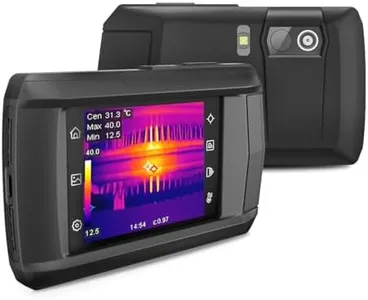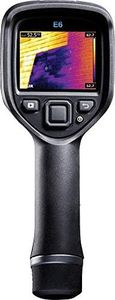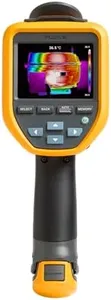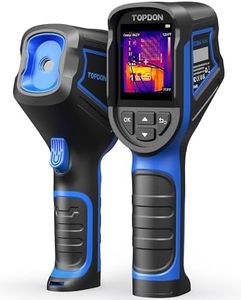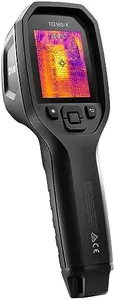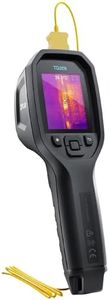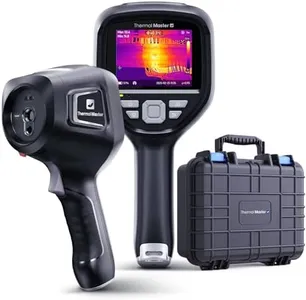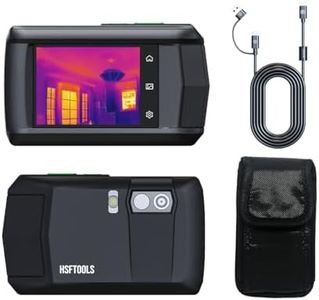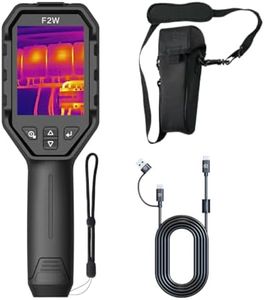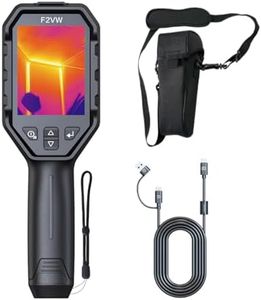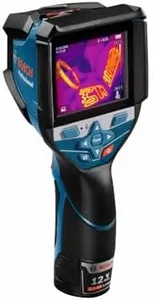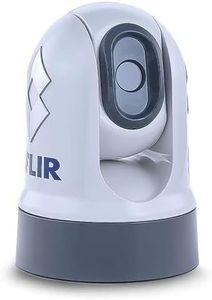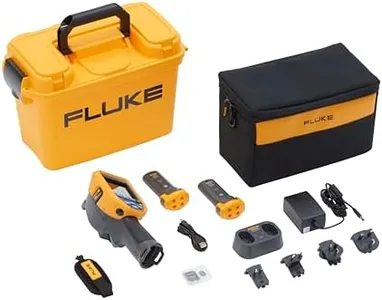10 Best Thermal Image Cameras 2025 in the United States
Our technology thoroughly searches through the online shopping world, reviewing hundreds of sites. We then process and analyze this information, updating in real-time to bring you the latest top-rated products. This way, you always get the best and most current options available.

Our Top Picks
Winner
FLIR E6-XT - Commercial Thermal Imaging Camera with WiFi. High Resolution Infrared Camera Ignite Cloud
Most important from
272 reviews
The FLIR E6-XT is a commercial thermal imaging camera designed for various applications like building, mechanical, and electrical inspections. It stands out with a high thermal resolution of 240 × 180 pixels, enhanced by FLIR's patented MSX technology. This tech overlays visual details on thermal images, making them clearer and easier to interpret. The temperature range it measures is quite broad, from -20°C to 550°C (-4°F to 1022°F), which makes it versatile for different environments and conditions.
FLIR products are known for good sensitivity in detecting minute temperature differences. On the connectivity front, the E6-XT includes WiFi, allowing images to be stored, edited, and shared via the FLIR Ignite Cloud. This feature, along with over-the-air updates, ensures the camera stays up-to-date with the latest improvements and saves users valuable time. Durability is another strong point, with an IP54 rating indicating good protection against dust and water, and the device's robust build quality.
Ergonomically, it is lightweight at 1.27 pounds and designed to be handheld, making it convenient for extended use. The display resolution is somewhat modest at 480p, which may not provide the sharpest detail for critical inspections. Additionally, while the battery is rechargeable and included, it's always worth considering the practical battery life during intensive use. The FLIR E6-XT is a capable and user-friendly thermal imaging camera with excellent connectivity and durability features.
Most important from
272 reviews
Fluke TiS75+ 27HZ, Thermal Imager
The Fluke TiS75+ 27HZ thermal imager is built tough for demanding industrial environments, featuring a rugged design that survives drops up to 2 meters and offers water and dust resistance (IP54). This makes it a reliable choice if you need a camera that won’t easily break during regular field use. It’s battery-powered and portable, weighing about 7.5 pounds, which is manageable but slightly heavier than some competitors.
One of this model’s standout features is its strong focus on helping users implement preventive maintenance programs efficiently. The Asset Tagging feature allows you to link thermal images to specific assets by scanning QR codes, creating an organized inspection timeline that saves time and helps spot issues early. Voice annotation and photo notes let you add clear explanations directly to images, which is great for documenting findings without confusion.
Connectivity is straightforward with the ability to connect to a computer for image review and organization. The 27Hz frame rate provides smooth thermal imaging suitable for most industrial tasks. The TiS75+ is well-suited for industrial users who prioritize durability and structured maintenance workflows, with ruggedness and asset management tools that help avoid downtime and streamline inspections.
TOPDON TC004 Mini Handheld Thermal Imaging Camera, 240 x 240 TISR Resolution, -4°F to 842°F, 15-Hour Battery Life, 128 x 128 IR Resolution, 25Hz Infrared Camera, High/Low Temp Alerts, Auto Shutdown
Most important from
296 reviews
The TOPDON TC004 Mini is a compact thermal imaging camera designed for everyday use in home inspections, electrical work, and machinery checks. It starts with a 128x128 thermal sensor but enhances images to 240x240 resolution using TISR technology, offering clear and detailed thermal views. Its 40°x30° field of view is wide enough for scanning larger areas, and the 25Hz refresh rate ensures smooth real-time imaging. Temperature measurement covers a useful range from -4°F to 842°F, suitable for various tasks from checking heating systems to spotting overheating components. One handy feature is the automatic high/low temperature alerts, which notify you instantly and save a photo for easy troubleshooting. The camera supports multiple color palettes, letting you choose the visual style that best suits your preference or work conditions.
With a 15-hour battery life and automatic shutoff options, it’s built to last through long inspections without frequent recharging, though you’ll need your own charging adapter since only the cable is provided. Its lightweight, pocket-friendly design and ergonomic grip make it comfortable for extended use. The device is also durable, rated IP54 for splash resistance and can handle drops up to 2 meters, making it well-suited for fieldwork. Storage allows up to 8,000 photos internally, simplifying data management. However, it lacks advanced connectivity features like Wi-Fi or Bluetooth, so transferring images requires connecting the device physically.
The TOPDON TC004 Mini functions as a reliable, easy-to-use thermal camera for homeowners and professionals looking for a portable, durable tool to perform routine thermal inspections without complex setup or high-end features.
